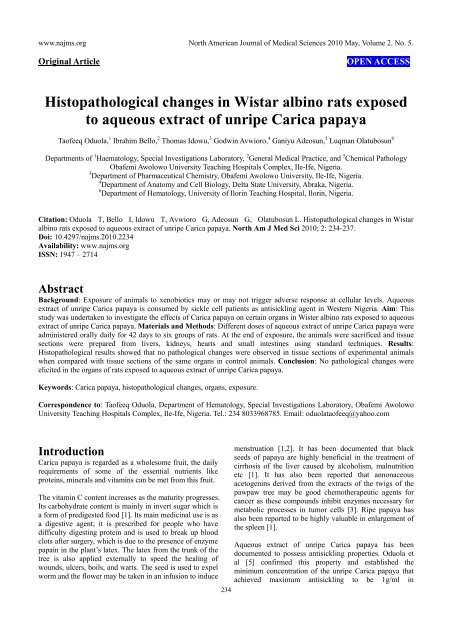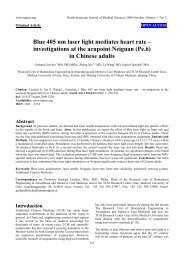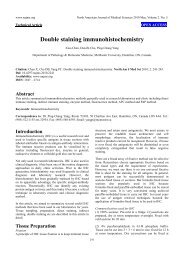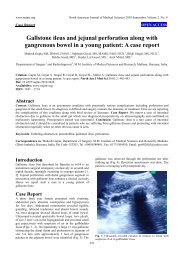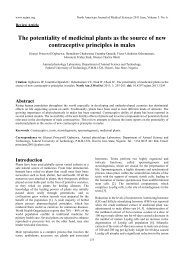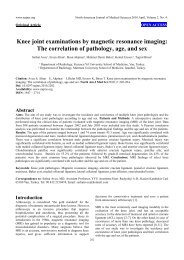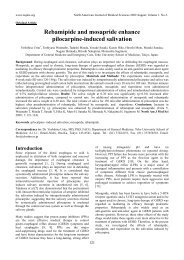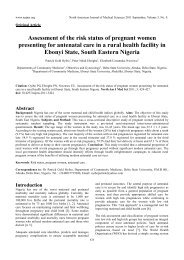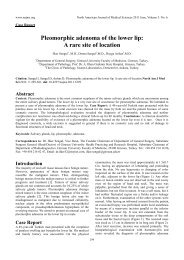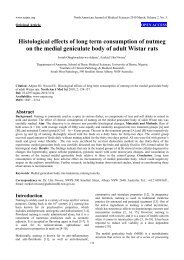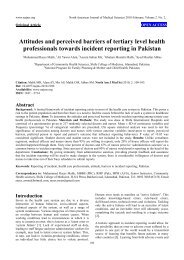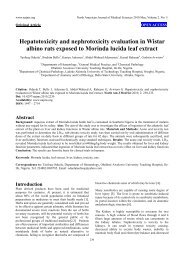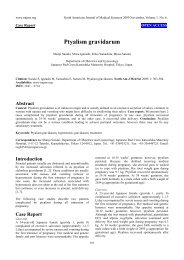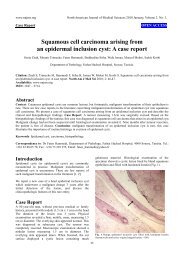Histopathological changes in Wistar albino rats exposed to aqueous ...
Histopathological changes in Wistar albino rats exposed to aqueous ...
Histopathological changes in Wistar albino rats exposed to aqueous ...
Create successful ePaper yourself
Turn your PDF publications into a flip-book with our unique Google optimized e-Paper software.
www.najms.org North American Journal of Medical Sciences 2010 May, Volume 2. No. 5.<br />
Orig<strong>in</strong>al Article<br />
OPEN ACCESS<br />
<strong>His<strong>to</strong>pathological</strong> <strong>changes</strong> <strong>in</strong> <strong>Wistar</strong> alb<strong>in</strong>o <strong>rats</strong> <strong>exposed</strong><br />
<strong>to</strong> <strong>aqueous</strong> extract of unripe Carica papaya<br />
Taofeeq Oduola, 1 Ibrahim Bello, 2 Thomas Idowu, 3 Godw<strong>in</strong> Avwioro, 4 Ganiyu Adeosun, 5 Luqman Olatubosun 6<br />
Departments of 1 Haema<strong>to</strong>logy, Special Investigations Labora<strong>to</strong>ry, 2 General Medical Practice, and 5 Chemical Pathology<br />
Obafemi Awolowo University Teach<strong>in</strong>g Hospitals Complex, Ile-Ife, Nigeria.<br />
3 Department of Pharmaceutical Chemistry, Obafemi Awolowo University, Ile-Ife, Nigeria.<br />
4 Department of Ana<strong>to</strong>my and Cell Biology, Delta State University, Abraka, Nigeria.<br />
6 Department of Hema<strong>to</strong>logy, University of Ilor<strong>in</strong> Teach<strong>in</strong>g Hospital, Ilor<strong>in</strong>, Nigeria.<br />
Citation: Oduola T, Bello I, Idowu T, Avwioro G, Adeosun G, Olatubosun L. <strong>His<strong>to</strong>pathological</strong> <strong>changes</strong> <strong>in</strong> <strong>Wistar</strong><br />
alb<strong>in</strong>o <strong>rats</strong> <strong>exposed</strong> <strong>to</strong> <strong>aqueous</strong> extract of unripe Carica papaya. North Am J Med Sci 2010; 2: 234-237.<br />
Doi: 10.4297/najms.2010.2234<br />
Availability: www.najms.org<br />
ISSN: 1947 – 2714<br />
Abstract<br />
Background: Exposure of animals <strong>to</strong> xenobiotics may or may not trigger adverse response at cellular levels. Aqueous<br />
extract of unripe Carica papaya is consumed by sickle cell patients as antisickl<strong>in</strong>g agent <strong>in</strong> Western Nigeria. Aim: This<br />
study was undertaken <strong>to</strong> <strong>in</strong>vestigate the effects of Carica papaya on certa<strong>in</strong> organs <strong>in</strong> Wister alb<strong>in</strong>o <strong>rats</strong> <strong>exposed</strong> <strong>to</strong> <strong>aqueous</strong><br />
extract of unripe Carica papaya. Materials and Methods: Different doses of <strong>aqueous</strong> extract of unripe Carica papaya were<br />
adm<strong>in</strong>istered orally daily for 42 days <strong>to</strong> six groups of <strong>rats</strong>. At the end of exposure, the animals were sacrificed and tissue<br />
sections were prepared from livers, kidneys, hearts and small <strong>in</strong>test<strong>in</strong>es us<strong>in</strong>g standard techniques. Results:<br />
<strong>His<strong>to</strong>pathological</strong> results showed that no pathological <strong>changes</strong> were observed <strong>in</strong> tissue sections of experimental animals<br />
when compared with tissue sections of the same organs <strong>in</strong> control animals. Conclusion: No pathological <strong>changes</strong> were<br />
elicited <strong>in</strong> the organs of <strong>rats</strong> <strong>exposed</strong> <strong>to</strong> <strong>aqueous</strong> extract of unripe Carica papaya.<br />
Keywords: Carica papaya, his<strong>to</strong>pathological <strong>changes</strong>, organs, exposure.<br />
Correspondence <strong>to</strong>: Taofeeq Oduola, Department of Hema<strong>to</strong>logy, Special Investigations Labora<strong>to</strong>ry, Obafemi Awolowo<br />
University Teach<strong>in</strong>g Hospitals Complex, Ile-Ife, Nigeria. Tel.: 234 8033968785. Email: oduolataofeeq@yahoo.com<br />
Introduction<br />
Carica papaya is regarded as a wholesome fruit, the daily<br />
requirements of some of the essential nutrients like<br />
prote<strong>in</strong>s, m<strong>in</strong>erals and vitam<strong>in</strong>s can be met from this fruit.<br />
The vitam<strong>in</strong> C content <strong>in</strong>creases as the maturity progresses.<br />
Its carbohydrate content is ma<strong>in</strong>ly <strong>in</strong> <strong>in</strong>vert sugar which is<br />
a form of predigested food [1]. Its ma<strong>in</strong> medic<strong>in</strong>al use is as<br />
a digestive agent; it is prescribed for people who have<br />
difficulty digest<strong>in</strong>g prote<strong>in</strong> and is used <strong>to</strong> break up blood<br />
clots after surgery, which is due <strong>to</strong> the presence of enzyme<br />
papa<strong>in</strong> <strong>in</strong> the plant’s latex. The latex from the trunk of the<br />
tree is also applied externally <strong>to</strong> speed the heal<strong>in</strong>g of<br />
wounds, ulcers, boils, and warts. The seed is used <strong>to</strong> expel<br />
worm and the flower may be taken <strong>in</strong> an <strong>in</strong>fusion <strong>to</strong> <strong>in</strong>duce<br />
234<br />
menstruation [1,2]. It has been documented that black<br />
seeds of papaya are highly beneficial <strong>in</strong> the treatment of<br />
cirrhosis of the liver caused by alcoholism, malnutrition<br />
etc [1]. It has also been reported that annonaceous<br />
ace<strong>to</strong>gen<strong>in</strong>s derived from the extracts of the twigs of the<br />
pawpaw tree may be good chemotherapeutic agents for<br />
cancer as these compounds <strong>in</strong>hibit enzymes necessary for<br />
metabolic processes <strong>in</strong> tumor cells [3]. Ripe papaya has<br />
also been reported <strong>to</strong> be highly valuable <strong>in</strong> enlargement of<br />
the spleen [1].<br />
Aqueous extract of unripe Carica papaya has been<br />
documented <strong>to</strong> possess antisickl<strong>in</strong>g properties. Oduola et<br />
al [5] confirmed this property and established the<br />
m<strong>in</strong>imum concentration of the unripe Carica papaya that<br />
achieved maximum antisickl<strong>in</strong>g <strong>to</strong> be 1g/ml <strong>in</strong>
www.najms.org North American Journal of Medical Sciences 2010 May, Volume 2. No. 5.<br />
physiological sal<strong>in</strong>e. Solvent partition<strong>in</strong>g revealed that the<br />
antisickl<strong>in</strong>g agent resides <strong>in</strong> the ethyl acetate fraction of<br />
the extract [5]. The results of the acute oral <strong>to</strong>xicity study<br />
<strong>in</strong> Wister alb<strong>in</strong>o <strong>rats</strong> showed the LD 50 of the <strong>aqueous</strong><br />
extract of the unripe Carica papaya <strong>to</strong> be 2520mg/kg [6].<br />
Ingestion of <strong>aqueous</strong> extract of unripe Carica papaya has<br />
been reported <strong>to</strong> have no <strong>to</strong>xic effect on liver, kidney and<br />
bone marrow functions <strong>in</strong> Wister alb<strong>in</strong>o <strong>rats</strong> [6]. Non<strong>to</strong>xic<br />
effect of <strong>in</strong>gestion of <strong>aqueous</strong> extract of unripe Carica<br />
papaya on liver functions <strong>in</strong> sickle cell patients of different<br />
age groups had also been documented [7]. The effect of<br />
<strong>in</strong>gestion of <strong>aqueous</strong> extract of unripe Carica papaya on<br />
kidney function <strong>in</strong> sickle cell patients was also reported <strong>to</strong><br />
be normal [8]. Hema<strong>to</strong>logical parameter was also<br />
established <strong>to</strong> be normal <strong>in</strong> sickle patients who <strong>in</strong>gested<br />
unripe Carica papaya <strong>aqueous</strong> extract for 6 months [9].<br />
The cell is the pivotal unit <strong>in</strong> the response <strong>to</strong> chemicals. It<br />
is the central unit of organization, which <strong>to</strong>gether with the<br />
extra cellular matrix, a modula<strong>to</strong>r of many cellular<br />
functions, controls and ma<strong>in</strong>ta<strong>in</strong>s at a steady-state the<br />
<strong>in</strong>ternal environment of all functions/structures and the<br />
dispens<strong>in</strong>g of energy <strong>in</strong> the immediate cell neighborhood<br />
and even at sites remotes <strong>to</strong> a given tissue [10]. Hence the<br />
present study is designed <strong>to</strong> assess his<strong>to</strong>logical <strong>changes</strong> <strong>in</strong><br />
Wister alb<strong>in</strong>o <strong>rats</strong> <strong>exposed</strong> <strong>to</strong> oral adm<strong>in</strong>istration of unripe<br />
Carica papaya <strong>aqueous</strong> extract.<br />
with an au<strong>to</strong>matic tissue processor by dehydrat<strong>in</strong>g through<br />
70%, 90%, 95% and two <strong>changes</strong> of absolute ethanol for<br />
90m<strong>in</strong>utes each. Clear<strong>in</strong>g was achieved through two<br />
<strong>changes</strong> of xylene for 2hours each; and <strong>in</strong>filtrat<strong>in</strong>g with<br />
two <strong>changes</strong> of paraff<strong>in</strong> wax for 2hours. Sections were cut<br />
at 5μm with a rotary micro<strong>to</strong>me. The sections were sta<strong>in</strong>ed<br />
by haema<strong>to</strong>xyl<strong>in</strong> and eos<strong>in</strong> (H&E) method [11], exam<strong>in</strong>ed<br />
and pho<strong>to</strong>graphed us<strong>in</strong>g a light microscope.<br />
Results<br />
The pho<strong>to</strong>micrographs of liver, kidney, heart and small<br />
<strong>in</strong>test<strong>in</strong>e tissue sections from control and experimental <strong>rats</strong><br />
sta<strong>in</strong>ed with haema<strong>to</strong>xyl<strong>in</strong> and eos<strong>in</strong> are shown below. The<br />
tissue sections of the experimental animals were<br />
essentially normal when compared with the control<br />
sections (Fig. 1).<br />
Materials and Methods<br />
Matured fresh unripe Carica papaya fruit was obta<strong>in</strong>ed <strong>in</strong> a<br />
local garden <strong>in</strong> Ile-Ife, and was authenticated at the<br />
herbarium of the Botany Department, Obafemi Awolowo<br />
University, Ile-Ife, the herbarium number is 14729. The<br />
fruit was cut <strong>in</strong><strong>to</strong> pieces; extracted with 5 liters of<br />
methanol at room temperature for 72 hours and<br />
concentrated <strong>to</strong> dryness <strong>in</strong>-vacuo on a rotary evapora<strong>to</strong>r <strong>to</strong><br />
obta<strong>in</strong> the crude methanolic extract.<br />
Male and Female Wister alb<strong>in</strong>o <strong>rats</strong> weigh<strong>in</strong>g 195-225g (X<br />
205.6g) obta<strong>in</strong>ed from the animal house of the faculty of<br />
pharmacy, Obafemi Awolowo University, Ile-Ife, Nigeria<br />
were used for the study. They were housed <strong>in</strong> plastic rat<br />
cages <strong>in</strong> groups of six <strong>rats</strong> per cage <strong>in</strong> a room with<br />
temperature of 25 + 2 0 C, 12 hours natural light and<br />
12hours darkness with free access <strong>to</strong> tap water and dry rat<br />
pellet (purchased at Ogo Oluwa Enterprises, Ile-Ife,<br />
Nigeria). They were allowed <strong>to</strong> acclimatize for three days<br />
prior <strong>to</strong> the experiment.<br />
Fig. 1 The his<strong>to</strong>pathological exam<strong>in</strong>ation of all the tissue<br />
sections of the control and experimental animals were essentially<br />
normal as no pathological lesions were observed.<br />
Plates 1a, 1b, 1c and 1d (x400) were sections of <strong>in</strong>test<strong>in</strong>e, kidney,<br />
Graded doses of the extract were adm<strong>in</strong>istered orally <strong>to</strong> six heart and liver respectively of control animals treated with<br />
groups of <strong>rats</strong> on daily basis for 42days. Rats <strong>in</strong> group 1 normal sal<strong>in</strong>e and sta<strong>in</strong>ed with H&E. Plates 2a, 2b, 2c and 2d<br />
served as control and received normal sal<strong>in</strong>e (0.85% NaCl). (x400) were sections of <strong>in</strong>test<strong>in</strong>e, kidney, heart and liver<br />
The animals <strong>in</strong> groups II, III, IV, V and VI received 50mg, respectively of group II animals that received 50mg/kg of the<br />
100mg, 150mg, 200mg and 250mg/kg body weight<br />
extract. Plates 3a, 3b, 3c and 3d (x400) were sections of <strong>in</strong>test<strong>in</strong>e,<br />
kidney, heart and liver respectively of group III animals that<br />
respectively, (these doses were based on previous report<br />
received 100mg/kg of the extract. Plates 4a, 4b, 4c and 4d (x400)<br />
[6]). At the end of 42-day extract exposure, the animals were sections of <strong>in</strong>test<strong>in</strong>e, kidney, heart and liver respectively of<br />
were sacrificed by cervical dislocation under ether group IV animals that received 150mg/kg of the extract. Plates 5a,<br />
anesthesia. The livers, kidneys, hearts and small <strong>in</strong>test<strong>in</strong>es 5b, 5c and 5d (x400) were sections of <strong>in</strong>test<strong>in</strong>e, kidney, heart and<br />
of the <strong>rats</strong> were harvested and fixed <strong>in</strong> 10% formol sal<strong>in</strong>e liver respectively of group V animals that received 200mg/kg of<br />
for 48hours and processed for paraff<strong>in</strong> wax embedd<strong>in</strong>g the extract. Plates 6a, 6b, 6c and 6d (x400 ) were sections of<br />
235
www.najms.org North American Journal of Medical Sciences 2010 May, Volume 2. No. 5.<br />
<strong>in</strong>test<strong>in</strong>e, kidney, heart and liver respectively of group VI animals<br />
that received 250mg/kg of the extract.<br />
Discussion<br />
It has been reported that the safety assessment <strong>in</strong><br />
experimental animals of both medic<strong>in</strong>al and non-medic<strong>in</strong>al<br />
biologically active chemicals has been very successful <strong>in</strong><br />
predict<strong>in</strong>g <strong>to</strong>xicity <strong>in</strong> humans [4]. It has also been<br />
documented that the major advantages of precl<strong>in</strong>ical safety<br />
assessment studies are the known responses of<br />
experimental species, the controlled conditions under<br />
which they can be ma<strong>in</strong>ta<strong>in</strong>ed and the establishment of<br />
appropriate metrics, such as tissue volume rates, which<br />
can be applied <strong>to</strong> extrapolation of f<strong>in</strong>d<strong>in</strong>gs <strong>in</strong> labora<strong>to</strong>ry<br />
animals <strong>to</strong> assessment of possible human effects. In<br />
general, the response(s) of humans is similar <strong>to</strong> that of<br />
experimental animals, with notable exceptions, such as<br />
peroxisome prolifera<strong>to</strong>rs [13] and α2u globul<strong>in</strong><br />
nephropathy <strong>in</strong>ducers [14] that do not elicit <strong>in</strong> humans the<br />
same effects as <strong>in</strong> rodents. Liver and kidney are important<br />
organs of metabolism, de<strong>to</strong>xification, s<strong>to</strong>rage and<br />
excretion of xenobiotics and their metabolites and<br />
especially vulnerable <strong>to</strong> damage [15]. Small <strong>in</strong>test<strong>in</strong>e and<br />
heart just like any other organ can also be affected by <strong>to</strong>xic<br />
effect of chemicals.<br />
From the present study, it was shown that the tissue<br />
section of liver, kidney, heart and small <strong>in</strong>test<strong>in</strong>e of control<br />
animals were essentially normal. There were also no<br />
lesions (pathological <strong>changes</strong>) <strong>in</strong> the tissues of the animals<br />
that received various doses of the extract. The present<br />
f<strong>in</strong>d<strong>in</strong>g is <strong>in</strong> agreement with the previous reports on<br />
biochemical and hema<strong>to</strong>logical response <strong>in</strong> Wister alb<strong>in</strong>o<br />
<strong>rats</strong> <strong>exposed</strong> <strong>to</strong> <strong>aqueous</strong> extract of unripe Carica papaya<br />
[6]. In conclusion, <strong>in</strong>gestion of <strong>aqueous</strong> extract of unripe<br />
Carica papaya has no adverse effect on the tissues of the<br />
organs studied <strong>in</strong> the <strong>rats</strong>. However, more work is<br />
suggested at the sub cellular levels and characterization of<br />
the active substance <strong>in</strong> the <strong>aqueous</strong> extract of unripe<br />
Carica papaya.<br />
Acknowledgements<br />
The authors are grateful <strong>to</strong> Mr. Solomon and Mr. Owolabi,<br />
of Animal House, Faculty of Pharmacy, Obafemi Awolowo<br />
University, Ile-Ife, for render<strong>in</strong>g technical assistance and<br />
Professor V.O Anosa, Faculty of Veter<strong>in</strong>ary Medic<strong>in</strong>e,<br />
University of Ibadan, Ibadan for report<strong>in</strong>g the slides.<br />
All authors made substantial contributions right from<br />
<strong>in</strong>ception <strong>to</strong> the end of the study. There is no conflict of<br />
<strong>in</strong>terest <strong>in</strong> whatever form.<br />
References<br />
1. Papaya Natural Benefits and Curative properties<br />
(Accessed March 15, 2010,<br />
at http://www.best-home-remeies.com/herbalmedic<strong>in</strong><br />
e/fruits/papaya.htm)<br />
2. Ogoda, Onah J, Akubue Pl, Okide GB. The k<strong>in</strong>etics of<br />
reversal of presickled erythrocytes by the <strong>aqueous</strong><br />
extracts of Cajanus cajan seeds. Phy<strong>to</strong>ther Res 2002,<br />
16(8):748-750.<br />
3. Zhao GX, Hui YH, Rupprecht JK, Mclaughl<strong>in</strong> JL,<br />
wood KV. “Additional bioactive compounds and<br />
triobac<strong>in</strong>, a novel highly cy<strong>to</strong><strong>to</strong>xic ace<strong>to</strong>gen<strong>in</strong>, from<br />
the bark of Asim<strong>in</strong>a trioba.” J Nat Prod 1992;<br />
52:347-356.<br />
4. Zhao GX, Gu Zm, Zeng L, Chao JF, Wood KV,<br />
Kozoloski JF, Mclaughl<strong>in</strong> JL. The absolute<br />
configuration of trilobax<strong>in</strong> and trilob<strong>in</strong>, a novel highly<br />
potent ace<strong>to</strong>gen<strong>in</strong> from the stem bark of Asm<strong>in</strong>a<br />
Trioba (Annonacae). Tetrahedron 1995;<br />
51:7149-7160.<br />
5. Reiser MJ, Hui YH, Rupprecht JK, Kozolowski JF,<br />
Wood KV, McLaughl<strong>in</strong> JL, Hoye TR, Hanson PR,<br />
Zhuang ZP. Determ<strong>in</strong>ation of absolute configuration<br />
of stereogenic carb<strong>in</strong>ol centres <strong>in</strong> annonaceous<br />
ace<strong>to</strong>-enis by IH- and F-NMR analysis of Mosher<br />
ester derivatives. J Am Chem Soc 1992;<br />
114:10203-10213<br />
6. Thomas KD, Ajani B. Antisickl<strong>in</strong>g agent <strong>in</strong> an extract<br />
of unripe pawpaw fruit (Carica papaya). Trans R Soc<br />
Trop Med Hyg 1987; 81:510-511.<br />
7. Oduola T, Adeniyi FAA, Ogunyemi EO, Bello IS,<br />
Idowu TO. Antisickl<strong>in</strong>g agent <strong>in</strong> an extract of unripe<br />
pawpaw (Carica papaya): Is it real? African J<br />
Biotechnol 2006; 5:1947-1949.<br />
8. Oduola T, Adeniyi FAA, Ogunyemi EO, Bello IS,<br />
Idowu TO, Subair HG. Toxicity studies on an<br />
<strong>aqueous</strong> extract of unripe Carica papaya: Biochemical<br />
and haema<strong>to</strong>logical effect <strong>in</strong> <strong>Wistar</strong> alb<strong>in</strong>o <strong>rats</strong>. J Med<br />
Plant Res 2007; 1(1): 1-4.<br />
9. Oduola T, Adeniyi FAA, Ogunyemi EO, Idowu TO,<br />
Bello IS. Evaluation of the effects of <strong>in</strong>take of extract<br />
of unripe pawpaw (Carica papaya) on liver function <strong>in</strong><br />
sickle cell patients. World J Med Sci 2007;<br />
2(1):28-32.<br />
10. Oduola T, Adeniyi FAA, Ogunyemi EO, Bello IS,<br />
Idowu TO. Ingestion of <strong>aqueous</strong> extract of unripe<br />
Carica papaya has no adverse effect on kidney<br />
function. World J Med Sci 2008; 3(2):89-92.<br />
11. Oduola T, Adeniyi FAA, Adenaike FA, Ogunyemi<br />
EO, Bello IS, Idowu TO. Haema<strong>to</strong>logical response <strong>to</strong><br />
<strong>in</strong>take of unripe Carica papaya <strong>aqueous</strong> extract. IJMR<br />
2009; (1): 20-25.<br />
12. Iatropoulos MJ. Endocr<strong>in</strong>e considerations <strong>in</strong><br />
<strong>to</strong>xicologic pathology. Exp Toxicol Pathol 1994;<br />
45:391-410.<br />
13. Avwioro OG. His<strong>to</strong>chemistry and Tissue Pathology:<br />
Pr<strong>in</strong>ciples and techniques 1 st ed, Claverianum Centre,<br />
2002.<br />
14. Olson H, Bet<strong>to</strong>n G, Rob<strong>in</strong>son D, Thomas K, Monro A,<br />
Kolaja G, Lilly P, Sanders J, Sipes G, Bracken W,<br />
Dora<strong>to</strong> M, Van Denn K, Smith P, Berger B, Heller A.<br />
Concordance of the <strong>to</strong>xicity of pharmaceuticals <strong>in</strong><br />
humans and <strong>in</strong> animals. Regal Toxicol pharmacol<br />
2000; 32:56-67.<br />
236
www.najms.org North American Journal of Medical Sciences 2010 May, Volume 2. No. 5.<br />
15. International Agency for Research on cancer.<br />
Peroxisome proliferation and its role <strong>in</strong><br />
carc<strong>in</strong>ogenesis. Views and expert op<strong>in</strong>ions of an<br />
IARC work<strong>in</strong>g group, Lyon, France, IARC. IARC<br />
Technical Report No 24, 1995.<br />
16. Rice JM, Baan RA, Blettner M, Genevois – Charneau<br />
C, Grosse Y, McGregor DB, Partensky C, Wilbourn<br />
JD. Rodent tumours of ur<strong>in</strong>ary bladder, renal cortex,<br />
and thyroid gland <strong>in</strong> IARC monographs evaluations<br />
of carc<strong>in</strong>ogenic risk <strong>to</strong> humans. Toxicol Sci 1999;<br />
49:166-171.<br />
17. Brzoska MM, Moniuszko-Jakonium J,<br />
Pilat-Marc<strong>in</strong>kiewicz B, Sawcki B. Liver and kidney<br />
function and his<strong>to</strong>logy <strong>in</strong> <strong>rats</strong> <strong>exposed</strong> <strong>to</strong> cadmium<br />
and ethanol. Alcohol Alcoholism 2003; 38: 2-10.<br />
237


